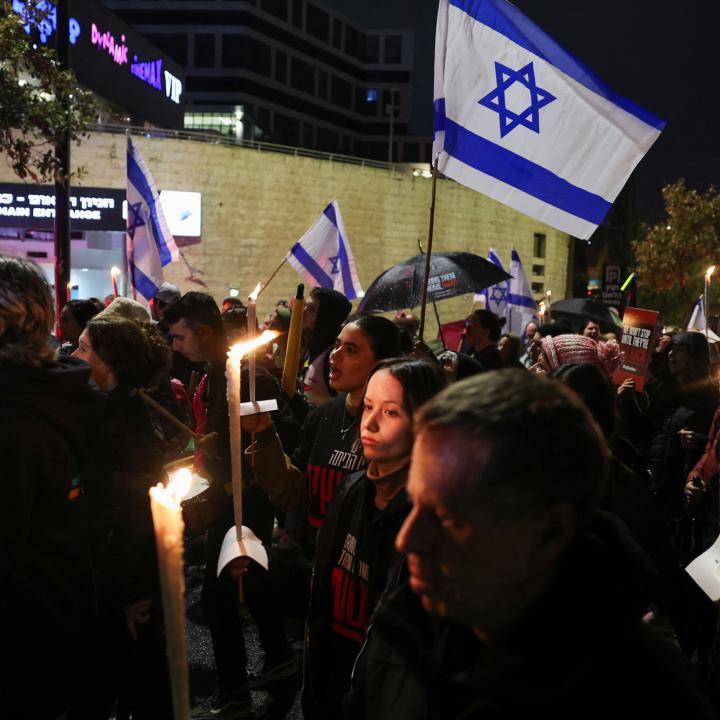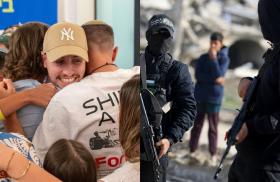
- Policy Analysis
- Fikra Forum
Hostages of the Mind: Hamas’s Strategic Use of Captivity in Cognitive Warfare

Hostage-taking has served multiple purposes for Hamas, including a novel use of cognitive warfare. This may prove to be a turning point in terrorist strategy that governments will need to learn how to counter effectively.
On October 7, 2023, Hamas launched a full-scale assault on Israel—an act of war marked by mass murder and destruction. Yet beyond its military dimension, the group also deployed a powerful psychological campaign. Among its most consequential tactics was the systematic abduction of over 250 civilians and soldiers, an unprecedented scale of hostage-taking that marks a new turning point in non-state actors’ use of kidnapping in modern warfare. While hostage-taking has served multiple purposes for Hamas, the organization’s strategy of cognitive warfare transformed hostages into instruments of psychological manipulation aimed at paralyzing Israeli leadership, fracturing public unity through emotional attrition, and manipulating international narratives by weaponizing empathy. Understanding hostage-taking as a long-term information and influence operation is critical to formulating an effective response against actors that engage in this tactic. Policymakers should move beyond viewing hostages solely as human shields or bargaining chips and also recognize them as instruments in a broader strategy of psychological warfare.
The October 7 Attack and the Logic of Captivity
Hamas’s abduction of 251 hostages, including infants, elderly civilians, soldiers, and foreign nationals, might have been viewed as an improvised gambit that took place amid the battlefield chaos that ensued on October 7. However, recovered materials from captured militants confirm that the abductions were guided by detailed printed manuals that instructed operatives on how to isolate, restrain, and evacuate hostages from Israeli territory. Some of these documents included guidelines for categorizing captives by utility for emotional impact and bargaining leverage, specifically prioritizing elderly individuals, women, and children. While hostage-taking served immediate military objectives—such as slowing Israel’s military response and extracting political concessions—it also functioned as a powerful instrument of cognitive warfare, used to stall Israeli decision-makers, fracture Israeli society, and reshape global perception.
Cognitive Warfare and National Paralysis
Cognitive warfare refers to the deliberate use of disinformation, information operations, psychological manipulation, or emotional coercion to influence how societies perceive reality, make decisions, and respond to threats. Hamas weaponized this concept by placing Israel’s leaders in an impossible position: every military operation in Gaza risked the lives of Israeli hostages held by Hamas. Moreover, the IDF maintains that the principle of ‘no soldier left behind’ is a core value and an obligation that applies to all Israelis, regardless of religion or background. But in the wake of October 7, applying that principle to the situation at hand with so many civilians and soldiers taken hostage proved to be not only practically complicated but also politically charged.
To this end, Hamas released hostage videos at politically sensitive moments to deepen internal Israeli divisions and strain Israel’s relationship with the United States. In April 2024, Hamas released a proof-of-life video of Hersch Goldberg-Polin following a sustained public campaign by his American-Israeli parents and senior U.S. officials that drew global attention. The timing exploited mounting pressure on the Israeli government from both domestic constituencies and the Biden administration. A year later, on the eve of Passover in April 2025, Hamas released its first video of Idan Alexander, the last known living American hostage, just days before his eventual release. Both cases illustrate how Hamas uses dual-national hostages as high-value assets to manipulate diplomatic timelines, divide allies, and heighten emotional pressure on Israeli leadership.
The IDF’s traditional deterrence logic of swift, overwhelming retaliation was therefore constrained by the humanitarian principles that the IDF upholds, and which Hamas sought to exploit. At the same time, Hamas’s military strategy also placed Palestinian civilians at risk: by embedding its fighters and infrastructure within and underneath civilian areas such as hospitals, schools, and residential homes, it intentionally used civilians as human shields. Civilian casualties were not merely collateral damage; they were instrumental in Hamas’s effort to undermine Israel’s legitimacy and turn global opinion against it.
The Families: Victims, Witnesses, Instruments
Hamas did not only seek to manipulate Israeli leadership, directly targeting hostage families as well. After October 7, the families of the hostages immediately became public figures, thrust into the media spotlight as advocates for their family members. As time passed, the hostage families grew increasingly skeptical that recovering the hostages was the foremost priority of the Israeli government. Groups like the Hostages and Missing Families Forum rapidly became central players in the national discourse, issuing impassioned pleas for restraint and focusing international media attention on the human toll of the war. Some families marched to Jerusalem to demand a ceasefire, joined by tens of thousands of Israelis. Others accused the government of sacrificing their loved ones on the altar of national honor.
Hamas weaponized their grief and vulnerability, sometimes sending them direct messages through media broadcasts or more discreet channels. These were designed to terrorize loved ones into applying pressure on the Israeli government or face threats that their relatives would be harmed. Those targeted included Einav Zengauker, mother of hostage Matan Zengauker, who became a symbol of the hostage families' public campaign. Hamas staged messages during a release “ceremony” by hanging a clock and writing “Matan is running out of time”—exploiting Einav’s prominent role to apply psychological pressure on both her and broader Israeli society.
Another example of psychological exploitation is the case of Guy Gilboa Dalal and Evyatar David, both of whom are still in captivity. During the most recent ceasefire in early 2025, Hamas brought them to a hostage transfer point, only to force them to watch other hostages being released. A video later surfaced of the two young men crying in the backseat of a car as they were driven back to the tunnels. Its professionally produced quality emphasized how, far from a logistical mishap, their presence was a deliberate act designed to deepen the anguish of the hostages and send a message to Israeli society: we control the timing, the lives, and the emotions of your children.
While some families turned their pain into advocacy, others refused to become symbols in a conflict they never chose. Yet all are subject to the same relentless dynamic: their grief, raw and legitimate, was reframed as a political indictment. Their trauma, like the fate of their loved ones, cannot be private, and instead becomes a public resource mined by Hamas, leveraged by political actors, and consumed by a watching world. This mass exposure created a secondary wave of psychological pressure. Public discourse in Israel began to polarize around who “owned” the hostage narrative. Was the government doing enough? Was military action making things worse? Were some hostages more “valuable” than others? Even within the families, unity frayed.
By embedding these dilemmas regarding civilians into Israel’s military calculus, Hamas aims to impede its decision-making process and deteriorate the public consensus in support of the war in Gaza. For Hamas, this fragmentation of unity among key figures in Israeli society was not coincidental—it was the objective. Moreover, the traumatic effect of hostage-taking extends far beyond the families of the captives. It reverberates across the entire Israeli public, which is caught between the desire for a military resolution that ends the threat of Hamas and the agony of endangering the lives of those held captive in Gaza. In this cognitive battlefield, the cruelty lies not only in what is done, but in what is withheld: information, clarity, and closure. The absence of knowledge about a loved one’s fate becomes a psychological weapon in and of itself—it is an omnipresent emotional burden. The weight of that, Hamas knows, is politically taxing, psychologically exhausting, and strategically exploitable.
Assessing the Israeli Response and Policy Recommendations
Despite ongoing diplomatic, intelligence, and military efforts, the Israeli government has failed to mount a cohesive response to Hamas’s brutal and calculated use of hostages for cognitive warfare. Messaging has been fragmented, often politicized, and strategically counterproductive. For example, Netanyahu criticized hostage-family protests, claiming they “harden Hamas’s demands and delay results.” Key ministers have prioritized political base-building over national unity, while no clear government policy has been articulated for securing the hostages’ release or resolving the broader conflict.
In contrast, the majority of the Israeli public has demonstrated consistent clarity in their attitudes towards the war: the return of hostages is seen as a top national priority, even at the cost of compromising other military objectives. Recent polls, including those conducted by Channel 12 News and INSS, found that 69 percent of Israelis, including 54 percent of coalition voters, support ending the war in exchange for the hostages’ return—results replicated by the Israel Democracy Institute. This societal resolve stands in stark contrast to governmental paralysis, and likewise highlights the psychological fault lines Hamas has deliberately sought to deepen.
Hamas’s mass hostage-taking may prove to be a turning point in terrorist strategy. Groups like Hamas and their state sponsors are adaptive actors. If mass abduction is seen to yield concessions, international sympathy, or diplomatic leverage, it will be replicated. To counter this, governments should draw on the Israeli experience to better prepare their psychological, strategic, and narrative defenses—before they are tested by similar crises.
- Reframe hostage-taking as psychological warfare: Recognize mass hostage-taking as a deliberate form of psychological and cognitive warfare, not just a humanitarian tragedy. National security and foreign policy frameworks must reflect this reality and treat perpetrators as strategically illegitimate.
- Prepare resilient societies: Develop national and international doctrines that include scenario planning, psychological preparedness, and public education for hostage crises—just as is done for terrorism or cyber threats. For example, Israel’s National Cyber Directorate regularly runs nationwide simulation exercises and public awareness campaigns to prepare institutions and civilians for large-scale cyberattacks. Launching inter-ministerial resilience initiatives encompassing health, education, defense, and diplomacy can further societal preparedness.
- Establish disciplined crisis messaging protocols: Rather than rely on rigid scripts, governments should train senior officials and spokespeople in strategic crisis communication: emphasizing psychological awareness, coordination, and consistency. Pre-established principles and centralized guidance can help reduce panic and narrative drift during emotionally charged hostage events.
- Strengthen global narrative capabilities: Create multilingual, proactive media units to shape the international conversation and counter adversarial influence campaigns. Leverage embassies, diaspora communities, and digital diplomacy to assert clarity on the Israeli perspective and intentional nature of cognitive warfare.
- Integrate the Israeli case into international learning: Treat the October 7 crisis as a case study in modern psychological warfare. Governments, international institutions, and civil society actors should incorporate Israel’s experience into training, doctrine, and contingency planning.
- Avoid reinforcing the hostage incentive structure: Acknowledge that past concessions regarding steeply asymmetric prisoner exchanges, such as the Jibril and Shalit deals, established a dangerous precedent. Future policy must set clear strategic limits to disincentivize mass abductions as a viable tactic.
The hostages taken on October 7 are not just prisoners in Gaza, they are captives in the global imagination. Hamas has deployed its hostage-taking strategy with precision not only to shield its fighters but to haunt Israeli society, weaken its leadership, and dominate international perception. This is the terrain of modern cognitive warfare: not just the battlefield, but the mind. Israel and its allies must now confront this reality, not with more panic, but with discipline and clarity. As Israel seeks to win the war, this means freeing more than hostages; it means liberating the national psyche from the traps that Hamas so expertly laid.


